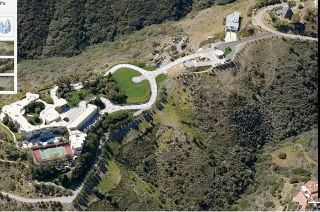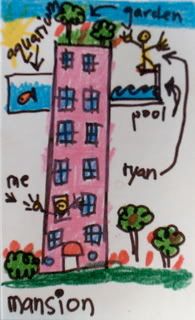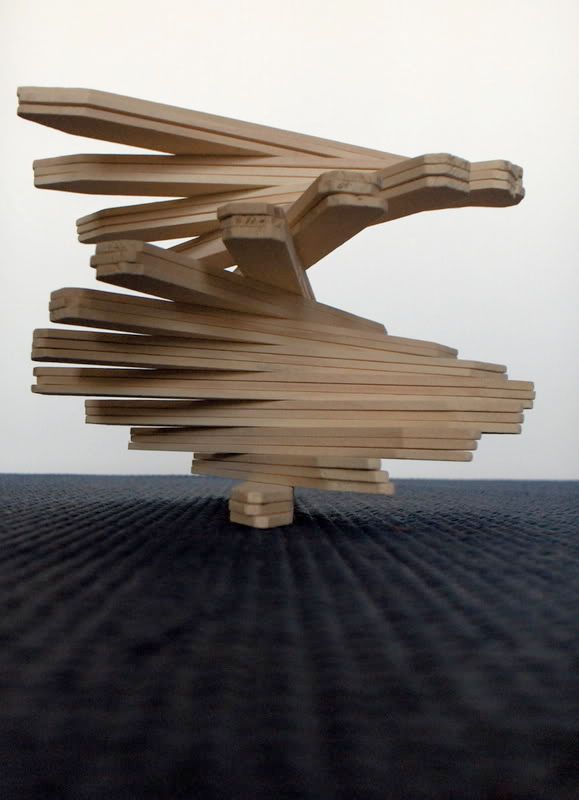In large populated cities where public services are more needed, space is limited. A huge Walmart or Costco is definitely out of the picture. Development firms are becoming wiser and trying to maximize small urban spaces by building up, instead of the outward sprawl they're used to doing in the past.
They call this urbanizing space.
I am a big fan of upward spreading. When I was little, I imagined a mansion to be a tall slim tower opposed to a huge sprawl. Growing up in LA, I thought the only way to build my future mansion was up, not out.
Malibu Mansion:

My Mansion:

I kid you not, this was the drawing I had spent hours and days drawing over and over again.
Well anyway, while I was listening to the NPR program, I started to think about upward spreading. Here in Riverside (Urban Sprawl, USA), much of the buildings are short, low to the ground, and a huge waste of space. (I have not ridden an elevator for about 3 years now.) The city is remodeling the Downtown Library by expanding out. When I heard these plans, I was saddened because there is a nice lawn in front of the library. The new plans would expand the front of the building out to the street, eliminating the lawn, the trees, and the nice benches. I wonder why they can't build up, instead of out.
I also started to think about my garden. With it's limited space, I am now starting to run out of space. I have been throwing plants together in sharing containers, but I would really like to have another raised box to grow more stuff. So I started thinking what if my garden was like a high-rise apartment? That would surely work. Better yet, I began to think about plants themselves, and how they structure themselves to be the most efficient at gathering sunlight. What if we could imitate them and appropriate nature's mathematical designs? There has to be a reason why plants evolved over millions of years, why not adopt some of their lessons?
This plant has been featured several times before. Can you tell this is one of my favorites? When you look at it from a bird's eye view, the leaves whorl around the stem in order to achieve maximum sunlight. When you draw radians through the leaves, you come across this formation:

I assumed this famous trigonometric diagram...

...as a schematic for an urbanized planter:

And upon rendering, the planter would look something like this:

This is really interesting to me. I will try to work out some more designs for planters.

6 comments:
I would be very interested to see that constructed. I'm no good at math...
Rock on!
I love you ideas for vertical gardening in a restricted space...depending on plant heights, the arms could pivot to their ideal height/light position.
I think you'd be interested in a book called The Golden Ratio, by Mario Livio. Apart from the use of the golden mean [Phi] in art and architecture, the book deals with natural expressions of Phi like the growth of the nautilus, and the distribution of branches in a plant.
VL
ah yes, the golden ratio! this i love and have been studying for many years. mathematics are magical and mysterious. I am currently working on an oyster-mushroom influenced planter schematic. Thanks for the words of encouragement. I will definitely look up that book.
-funtimehappygardenexplosion
an amazing piece! i could see that planter turn into an entire building in LA
Great idea! I agree with the others-I want to see a planter AND a building like that! (Not to be demanding, of course ;-)
Hello! I fell upon your blog searching for your Mother of Thousands plant (Kalanchoe daigremontiana)...I am happy you have featured it several times. I just found a big open area of land with trillions of these plants, and I wasn't sure what they were until I found photos online. I have another of these plants, and it has much broader leaves. I have a pic of mine (several) at my blog. Come visit! www.succulentsbyj.blogspot.com
P.S. So sorry for your Santa Ana winds this past fall. We had just visited southern California in August! (My fav place in the whole world)...I am in Florida!
Julie
Post a Comment